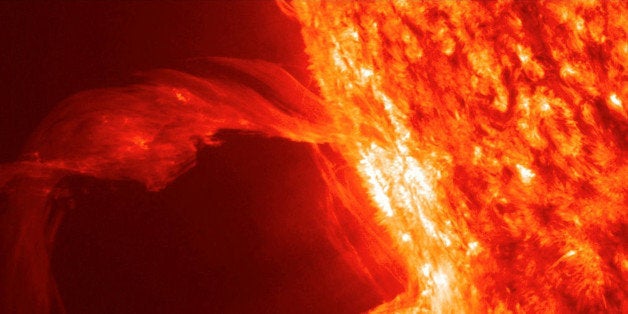
Earlier this week, two solar flares aimed in earth's direction erupted on the sun. What a spectacular picture from NASA has been making the rounds of the Internet; it's literally the muzzle flash of a stellar particle beam cannon looking right at us. Angling slightly above our planet's orbit, a gigantic blast of matter weighing many times our own earth called a coronal mass ejection or CME flies by in a cloud of charged particles. We will catch just the edge of it. It will make pretty aurora, an unhappy satellite or two, maybe a line of airliners following paths along the southern edge of the aurora instead of going the great circle route over the pole and you might even spot a savvy geek sporting a tin foil hat fashion statement this weekend.
It's not all fun and games. This particular solar flare was classified X1.6. X means intense but 1.6 is a number ranging from 1 to 9 where each number doubles the intensity. Above X9 are the super X storms; there's no upper limit number. According to NASA, the largest storm recorded since we've had satellites as an X28 in 1976. X1.6 is pretty small in the grand scheme of things, noteworthy but not dangerous. Catastrophic would be something like what's known as the "Carrington Event" that occurred in 1859, a super massive solar storm that maybe measured in the X40 range. It hit the earth dead center. It was powerful enough to cause telegraph stations to spontaneously catch fire from the excess energy it fed into the transmission lines of the era.
A direct hit by a little CME can cause temporary power outages. Protecting the grid from even these low level storms involves lowering the amount of power supplied via long distance transmission networks to reduce the load on the lines and transformers then filling in the demand as best as one can with more costly local coal and gas powered generating stations. It works to a certain extent although there are still the odd blackouts here and there.
A really big X storm hitting the earth head on strikes fear into the hearts of space scientists and U.S. power companies alike. There's so much energy dumped on the planet that power lines will heat up and sag to the ground starting fires. That energy can saturate the cores of transformers burning out the insulation literally welding the innards of railroad car sized electrical equipment into useless scrap. A Carrington-class CME could fry a large fraction of the power grid in as little as 90 seconds. It takes between six months to a year to make one of these main line transformers. Most of the factories that make them are overseas and in a worldwide emergency the U.S. would likely be wait listed. The sheer number required to repair the grid could mean vast areas would be without power for years.
Protecting key nodes is actually very doable. It involves installing surge protectors -- monster-sized ones -- and what's called a shunt to divert excess power that keeps the transformer cores from melting down. The U.S. military infrastructure -- long ago hardened for nuclear war -- is fully protected. Countries such as Russia and China have most of their grid protected as do a number of smaller nations. The U.S. commercial power grid is not presently so protected. Vulnerability studies of the U.S. commercial grid indicate that the older Eastern U.S. grid and Pacific Northwest grid are particularly vulnerable to large X-class CME's. The Texas and Western U.S. grids that use less susceptible direct current (DC) long distance transmission lines are less vulnerable.
Why hasn't the U.S. grid been hardened is a good question to consider asking the Federal Energy Regulatory Commission (FERC). Bypassing the trade associations of the industry that will tell you they cannot get to this because they are too busy dealing with carbon offset quotas and other what not, here's the one question you need to ask your local power company. "Will my family still have reliable electricity after a Carrington-class CME hits?" Tell them you'd really like it if they'd please report on this at least annually in the Management Discussion and Analysis (MD&A) and Sustainability sections of their financial reports to shareholders. Tell them you want the answer to be "Yes we are confident your family will have power even after a major solar storm." You know, just like in Russia and China.
In case you are wondering how remote a possibility this science fiction threat is, NASA's satellites picked one up on July 23, 2012 that was estimated to be as large or larger than the 1859 Carrington solar storm. A solar storm cleared out a region of space followed a few days later by a second large CME that was able to shoot particles even faster than normal. Fortunately, the sun aimed that blast at a point in space the earth was not in the path of at the time. According to some calculations, there's a 16 percent chance that a significant CME will hit the earth dead center in the next decade. You might want to tell your power company to think about hurrying up with that surge protector and shunt.
If you are interested, there's a website that has more information on this as well as other threats to the U.S. power grid at securethegrid.com
